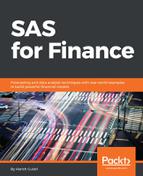There are numerous factors driving supply-and-demand changes. This, in turn, leads to changes in the inflation level. This can also at times cause deflation. Deflation is when the general prices tend to decrease in a basket or the broader economy. We will explore inflation by looking at aggregate demand (AD) and aggregate supply (AS):

In Figure 5.1, we can see that the aggregate supply is constant. When the aggregate demand in the GDP is at AD1, the price is P1. But as the AD increases to AD2, the price moves to P2. The percentage change in price is (P2-P1)/P1. The intersection of AD1 and AS resulted in price P1 and output Y1. However, the change in demand to AD2 has resulted in the aggregate output going up to Y2, but, in turn, the price also has gone up.
This phenomenon of constant supply but increased prices due to higher demand is known as demand-pull inflation. Some of the reasons that could trigger demand-pull inflation are as follows:
- Increased consumption but inelastic production: This can happen when the producers are unable to meet the increased demand by raising capacity. Inelastic production means that the producers are unable to increase or decrease production in the short run. In some instances, alternative products aren't available and this leads to increased demand and higher prices if supply remains constant. Consumers may shift to alternative products where possible. If in extreme summer, if the additional stock of cola products is unavailable, some of the consumption might move to fruit-based drinks. In such a scenario, the price increase may be minimal, as there is an alternative product.
- Monetary policy: If cheaper credit is made available, then higher borrowing may push house prices. This may further lead more people to buying furniture or renovating their existing or newly bought houses. While, in the case of furniture, the supplies may increase, the overall supply of houses may remain constant even though the builders may be rushing into building more houses in the medium term. This can cause house prices to go up, with a domino effect on related products and services.
- Government spending: In some developing economies, there is higher inflation compared to the European or the US economy. Governments in such a scenario have been known to give higher wage rises to government employees to ensure that they can afford a healthy lifestyle. In such a scenario, at times, higher wages, in turn, push demand, thereby increasing inflation rather than cooling it. Government spending in infrastructure or particular areas of the economy can also increase inflation. There is no single mechanism to manage inflation as is obvious from the long deflation cycle of the Japanese economy in spite of various government interventions.
- Earnings rising above productivity: This can happen when wages increase, whereas the productivity level in the economy remains the same.
In the AS graph in Figure 5.2, we can see the effect that a change in supply has on price when demand remains inelastic. Inelastic demand relates to the phenomenon where the demand remains constant irrespective of a supply decrease or increase. The demand for staple foods in a household may remain inelastic in the short run but, in the long run, families may change their food habits by shifting to alternative foods:

The AD doesn't change but the AS reduces from AS1 to AS2 in Figure 5.2. This results in the price increasing from P1 to P2 and the output shrinking from Y1 to Y2. With decreasing supply, AS-related inflation is also known as cost-push inflation, where, primarily, the price of raw materials and costs go up and this, in turn, has an impact on the price of the goods. The principle reasons for cost-pull inflation are as follows:
- Increase in wages: This has been observed in economies or sectors of an economy where the workers may be able to get deals that increase their wages every year above the general wage growth. This can lead to a situation where the cost of supplying the good to the market goes up while the demand remains constant.
- Raw material price increase: Cost-push inflation can have a ripple effect through the economy. The raw material price increase of commodities can lead to supply issues of various value-added products that depend on the raw materials.
- Exchange rate: A sudden shift in the exchange rate could end up pushing the cost of imported raw inputs. In energy deficient markets, the cost of importing petroleum or natural gas for energy consumption can push up the prices.
- Monopoly/cartels: The existence of monopolies or the formation of cartels can ensure that supply is restricted, thereby pushing up the price. While various countries have watchdogs in place to ensure that cartels can be disbanded and punished, mismanagement, or high entry barriers, leads to some sectors with a handful of players. This leads to the development of monopolies.
